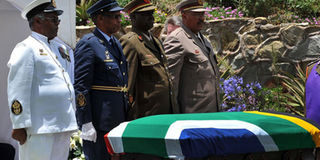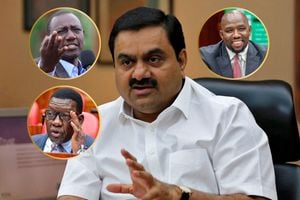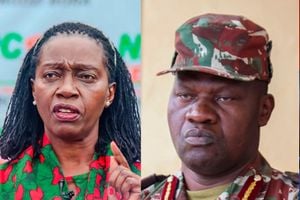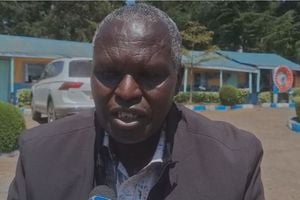Madiba clan traditions take centre stage

This handout photo taken and released by the Government Communication and Information System (GCIS) shows the coffin of South African former President Nelson Mandela at his burial site on December 13, 2013 in Qunu. Mandela, the revered icon of the anti-apartheid struggle in South Africa and one of the towering political figures of the 20th century, died in Johannesburg on December 5 at age 95. AFP PHOTO / EDMOND JIYANE
What you need to know:
- The body lay in the homestead overnight as part of custom, in the company of elders who addressed it according to custom to inform it of the proceedings that would follow and was delivered to the marquee where the service would be conducted.
- The Air Force also conducted what is known as the missing man fly-past which they do when one of their own has fallen, as a tribute to their former commander-in-chief.
The funeral programme was designed such that elder statesman Nelson Rolihlahla Mandela’s remains would be laid to rest at about 12 noon.
This was in keeping with Aba-Thembu traditions: when the sun is at its highest and the shadow at its shortest.
The burial was attended by at least several heads of State and government, members of royalty and heads of government delegations and international organization.
Among them were Tanzanian President Jakaya Kikwete, Britain’s Prince Charles, world renowned talk show host Oprah Winfrey and American civil rights activist Jesse Jackson.
Members of the family viewed the body between 6am and 6:30am after which a private homily for the family was delivered by Rev V Nyobole. The casket was draped between 6:45 and 7:00am by military pall bearers and then placed on a gun carriage for procession to the marquee for the funeral service.
The body lay in the homestead overnight as part of custom, in the company of elders who addressed it according to custom to inform it of the proceedings that would follow and was delivered to the marquee where the service would be conducted.
It was escorted by a military brass band and a formation of soldiers and honoured with a 21-gun salute.
The whole route from the homestead to the marquee was lined with soldiers on each side providing a guard of honour.
At 8:10am, South African time, the casket was borne into the venue of the funeral service by military pall bearers as a mass choir belted out a soulful dirge. Under the catafalque was a carpet made of cow hides.
The programme directors were ANC deputy president Cyril Ramaphosa and Ms Baleke Mbete announcing the proceedings from a stately platform with golden coloured arches and rows of 95 candles, with Mr Mandela’s portrait with his trademark smile in the background.
“They represent Madiba’s life. This is an honour to him to remember the years of his life and the contribution he made to this country,” Mr Ramaphosa said.
“No effort has been spared to make sure that this funeral service is what Tata would have liked to see this morning,” Ms Mbeta said. It was certainly a classic funeral service, organised to the hilt, timely and a far cry from the disorganised memorial service held at the First National Bank on Tuesday.
At 8:15, the congregation of mourners rose for the South African National Anthem to receive the casket.
Bishop Z Siwa who delivered the sermon after the tributes and related his Bible reading to Mr Mandela’s selflessness.
“Tata Nelson Mandela lived a life that sent a ray of hope for those he left behind. The fitting tribute would be that we strive for what he believed in,” Bishop Siwa told mourners.
“Well done good and faithful servant,” the bishop said of Mr Mandela. “We will always cherish the life you shared with this nation.”
The military pallbearers began their final march at about noon.
Only 450 people were allowed to an amphitheatre built next to the grave site.
The Air Force also conducted what is known as the missing man fly-past which they do when one of their own has fallen, as a tribute to their former commander-in-chief.




